“Locating Cyberfeminist Art in Singapore” presented by Aristarkhova
Symposium:
Session Title:
- Locating Cyberfeminism
Presentation Title:
- Locating Cyberfeminist Art in Singapore
Presenter(s):
Abstract:
This paper is a part of the panel “Locating Cyberfeminism” that seeks to present a varied set of cyberfeminist theories and art practices by situating them within specific political, technological and cultural contexts. While presenting papers that address issues of cultural difference within cyberfeminist art and aesthetics, this panel also attempts to widen the possibility of how cyberfeminism could be imagined. It could be enabled through the inclusion of projects, theories and practices that take place geographically and/or conceptually outside of what one can simplify as Western cyberfeminist trope. This trope often finds its origins in individual identity and body centered analysis. While acknowledging their immense influence on today’s situation with women, art and technology, this panel seeks to locate them within specific histories of Western (often white and middle-class) feminism, thus, opening up spaces for other histories and genealogies. Without dividing too neatly Western and non-Western locations, all presentations aim at contributing ‘other’ cyberfeminisms, often relying on comparative perspective to be helpful in our recognition of the politics of location and histories of cultural difference within this growing field.
In my paper I seek to provide a comparative analysis of cross-cultural art collaborations that are focused on the art works of subRosa cyberfeminist art collective. First, I outline the terminological difficulty using the concept of cyberfeminism for the purposes of my analysis. It is possible to argue very effectively for doing away with either parts of cyberfeminism especially today and in post-colonial situation: cyber art for being a passing fad and not political enough, while feminism portion for being assumed as a universal struggle for all women around the world, with a defi ning standard set, arguably in a colonialist fashion by Western white middle class women. However, it is more effective, I claim, to move beyond the terminological battles towards using this term as an umbrella for a variety of conceptual and creative practices that deal with gender and technology in the same fashion as ecofeminism has done for women and environment. This section of my paper will end with a certain takeover of this term that has been somewhat out of fashion lately, obsolete and therefore, becoming interesting again, especially in cyberfeminist postcolonial and post-communist ‘periphery’. Periphery is usually defined through working with art movements and concepts which are old and left behind by creative intellectual centers of the Western centers. The culture of innovation and creative consumption is looking for the next big thing, while cyberfeminism, like the music of the 90s, has become a rarity once again.
Second, I move on to establish the work of subRosa cyberfeminist art collective as a rare example of working with risky and unpopular topics in the area of art, science and technology: namely, issues of class, race and cultural difference in relation to technology and latest biomedical sciences. This work is not so unique in other parts of the world, and unites them with many artists who seek to combine “art, activism, and politics to explore and critique the effects of the intersections of the new information and biotechnologies on women’s bodies, lives, and work” (from www.cyberfeminism.net). Even though new media and electronic art scene has been slow in recognizing the importance of class, race, sexual or cultural difference, today it is catching up. After all, how long can we be inspired by our own merger with the machine? Often this recognition manifests itself as an exotic element, a spiritual or political “add-on” from places that are foreign to the mainstream ear (in terms of gender, it often leads to some references to ‘those Asian women assembling computers’), rather than attention to wider and more fundamental processes of economic and cultural imperialism. Therefore, I argue that certain subRosa’s works exhibit, albeit indirectly, what Derrida called globa-latinisation, especially international collaborative works. SubRosa’s insistence on recognizing global differences among women, being as ‘old-fashioned’ as cyberfeminism, is revealed in their texts and aesthetic processes, and is explored in my paper. Specifically, I am going to focus on the way in which subRosa deals with reproductive biomedical technologies.






